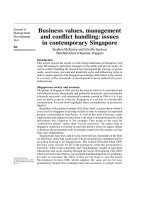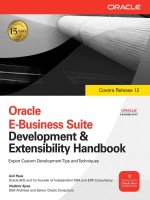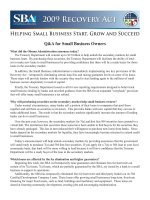Worry-FreeTM 7 Business Security Standard and Advanced Editions pot
Bạn đang xem bản rút gọn của tài liệu. Xem và tải ngay bản đầy đủ của tài liệu tại đây (5.02 MB, 506 trang )
Administrator’s Guide
Worry-Free
TM
Business Security
Standard and Advanced Editions
#1 at stopping threats before they reach your business
7
Administration Guide
Trend Micro Incorporated reserves the right to make changes to this document and to
the products described herein without notice. Before installing and using the software,
please review the readme files, release notes, and the latest version of the applicable user
documentation, which are available from the Trend Micro website at:
/>Trend Micro, the Trend Micro t-ball logo, TrendProtect, TrendSecure, Worry-Free,
OfficeScan, ServerProtect, PC-cillin, InterScan, and ScanMail are trademarks or
registered trademarks of Trend Micro, Incorporated. All other product or company
names may be trademarks or registered trademarks of their owners.
Copyright© 2010. Trend Micro Incorporated. All rights reserved.
Document Part Number: WBEM74598/100819
Release Date: October 2010
Product Name and Version No.: Trend Micro™ Worry-Free™ Business Security 7.0
Document Version No.: 1.01
Protected by U.S. Patent Nos. 5,951,698 and 7,188,369
The user documentation for Trend Micro™ Worry-Free™ Business Security is intended
to introduce the main features of the software and installation instructions for your
production environment. You should read through it prior to installing or using the
software.
Detailed information about how to use specific features within the software are available
in the online help file and the Knowledge Base at Trend Micro website.
Trend Micro is always seeking to improve its documentation. Your feedback is always
welcome. Please evaluate this documentation on the following site:
/>Contents
i
Contents
Chapter 1: Introducing Trend Micro™
Worry-Free™Business Security Standard and
Advanced
Overview of Trend Micro Worry-Free Business Security 1-2
What's New 1-2
Version 7.0 1-2
Key Features 1-3
The Trend Micro Smart Protection Network 1-3
Smart Feedback 1-3
Web Reputation 1-4
Email Reputation (Advanced only) 1-4
File Reputation 1-4
Smart Scan 1-5
URL Filtering 1-5
Benefits of Protection 1-5
Defense Components 1-6
Understanding Threats 1-10
Network Components 1-15
Sending Trend Micro Your Viruses 1-16
Chapter 2: Getting Started
Registering 2-2
Introducing the Web Console 2-2
Live Status 2-7
Viewing Computers 2-11
Trend Micro™ Worry-Free™ Business Security 7.0 Administration Guide
ii
Key Components 2-13
Security Server 2-13
Security Agent 2-13
Web Console 2-14
Clients 2-14
Virus Scan Engine 2-14
Chapter 3: Installing Agents
Security Agent Installation/Upgrade/Migration Overview 3-2
Installing Security Agents to Desktops and Servers 3-2
Performing a Fresh Install 3-5
Installing from an Internal Web Page 3-5
Installing with Login Script Setup 3-6
Installing with Client Packager 3-9
Installing with an MSI File 3-11
Installing with Remote Install 3-12
Installing with Vulnerability Scanner 3-14
Installing with Email Notification 3-16
Installing MSA from the Web Console (Advanced only) 3-16
Verifying the Agent Installation, Upgrade, or Migration 3-17
Verifying Client Installation with Vulnerability Scanner 3-18
Verifying Client-Server Connectivity 3-19
Testing the Client Installation with the EICAR Test Script 3-20
Removing Agents 3-20
Removing the SA Using the Agent Uninstallation Program 3-21
Removing the SA Using the Web Console 3-21
Removing the Agent from Exchange Servers (Advanced only) 3-22
Running the Messaging Security Agent Uninstallation Program
(Advanced only) 3-22
Contents
iii
Chapter 4: Managing Groups
Groups 4-2
Adding Groups 4-4
Adding Clients to Groups 4-5
Moving Clients 4-5
Replicating Group Settings 4-6
Importing and Exporting Settings 4-6
Removing Computers from the Web Console 4-7
Removing Inactive Security Agents 4-8
Chapter 5: Managing Basic Security Settings
Options for Desktop and Server Groups 5-2
Configuring Real-time Scan 5-4
Managing the Firewall 5-4
Configuring the Firewall 5-7
Working with Firewall Exceptions 5-9
Disabling the Firewall 5-11
Intrusion Detection System 5-11
Web Reputation 5-13
Configuring Web Reputation 5-14
URL Filtering 5-16
Behavior Monitoring 5-17
Device Control 5-20
User Tools 5-22
Configuring User Tools 5-22
Configuring Client Privileges 5-23
Configuring the Quarantine 5-25
Configuring the Quarantine Directory 5-26
Trend Micro™ Worry-Free™ Business Security 7.0 Administration Guide
iv
Chapter 6: Managing Scans
About Scanning 6-2
Scan Types 6-2
Scan Methods 6-3
Selecting the Scan Method 6-4
Enabling Real-Time Scanning 6-4
Running Manual Scans on Desktops and Servers 6-5
Virus Pattern 6-6
Running Scheduled Scans for Desktops and Servers 6-7
Scheduling Scans 6-9
Configuring Antivirus/Anti-Spyware Scans for Desktops and Servers 6-10
Modifying the Spyware/Grayware Approved List 6-14
Uncleanable Files 6-16
Mail Scan 6-17
Trojan Ports 6-18
Chapter 7: Managing Updates
Updating the Security Server 7-2
Hot Fixes, Patches, and Service Packs 7-3
Updating Security Agents 7-3
ActiveUpdate 7-4
Agent Update Sources 7-5
Configuring an Update Source for the SS and Agents 7-5
Configuring Alternative Update Sources for Security Agents 7-8
Update Agents 7-10
Using Update Agents 7-13
Manually Updating Components 7-15
Scheduling Component Updates 7-16
Updatable Components 7-18
Contents
v
Chapter 8: Managing Notifications
Notifications 8-2
Configuring Events for Notifications 8-3
Customizing Notification Email Messages 8-6
Tokens 8-6
Configuring Notification Settings for Microsoft Exchange Servers
(Advanced only) 8-7
Chapter 9: Managing the Messaging Security Agent
(Advanced only)
Messaging Security Agents 9-3
Messaging Security Agent Actions 9-5
Configuring Scan Options for Microsoft Exchange Servers 9-7
Installing MSAs to Microsoft Exchange Servers 9-9
Removing Microsoft Exchange Servers from the Web Console 9-11
Antivirus 9-12
Configuring Real-Time Scans for Exchange Servers 9-13
Manual Scans for Microsoft Exchange Servers 9-17
Scheduled Scans for Microsoft Exchange Servers 9-19
Configuring Manual or Scheduled Scans for Exchange Servers 9-20
Anti-Spam 9-23
Configuring Anti-Spam 9-24
Spam Detection Settings 9-25
Managing End User Quarantine 9-26
Email Reputation 9-28
Content Scanning 9-30
Phishing Incidents 9-32
Detecting and Removing Phishing Incidents 9-32
Content Filtering 9-39
Adding/Editing Content Filtering Rules 9-41
Creating Content Filtering Rules 9-43
Creating Content Filtering Rules for All Matching Conditions 9-45
Creating Exceptions to Content Filtering Rules 9-46
Trend Micro™ Worry-Free™ Business Security 7.0 Administration Guide
vi
Editing Content Filtering Rules 9-47
Removing Content Filtering Rules 9-49
Data Loss Prevention 9-65
Preparatory Work 9-66
Data Loss Prevention Rules 9-66
Pre-approved Domains and Approved Senders 9-82
Attachment Blocking 9-87
Selecting Blocking Targets 9-87
Attachment Blocking Actions 9-88
Configuring Attachment Blocking 9-89
Real-time Monitor 9-90
Web Reputation 9-91
Configuring Web Reputation Settings 9-93
Messaging Agent Quarantine 9-93
Configuring Quarantine Directories 9-94
Agent Quarantine Folder 9-96
Querying Quarantine Directories 9-97
Maintaining Quarantine Directories 9-100
Managing the End User Quarantine Tool 9-101
Operations 9-102
Notification Settings 9-103
Spam Maintenance 9-105
Trend Support/Debugger 9-106
Replicating Settings for Microsoft Exchange Servers 9-108
Adding a Disclaimer to Outbound Email Messages 9-108
Configuring Exclusions for Messaging Security Agents 9-109
Advanced Scan Options for Microsoft Exchange Servers 9-111
Advanced Macro Scanning 9-112
Internal Address Definition 9-113
Contents
vii
Chapter 10: Using Outbreak Defense
Outbreak Defense Strategy 10-2
Outbreak Defense Current Status 10-4
Threat Cleanup 10-6
Vulnerability Assessment 10-7
Vulnerability Assessment Pattern File 10-7
Potential Threat 10-8
Configuring Outbreak Defense Settings 10-10
Outbreak Defense Exceptions 10-14
Removing Ports from the Exceptions List 10-16
Configuring Vulnerability Assessment Settings 10-16
Cleanup Services 10-17
Viewing Automatic Outbreak Defense Details 10-18
Chapter 11: Managing Global Settings
Configuring Global Preferences 11-2
Internet Proxy Options 11-3
SMTP Server Options 11-5
Desktop/Server Options 11-6
System Options 11-13
Chapter 12: Using Logs and Reports
Logs 12-2
Using Log Query 12-4
Deleting Logs 12-6
Reports 12-7
One-Time Reports 12-8
Interpreting Reports 12-8
Generating Reports 12-11
Adding a Scheduled Report 12-12
Editing Scheduled Reports 12-13
Trend Micro™ Worry-Free™ Business Security 7.0 Administration Guide
viii
Managing Logs and Reports 12-14
Maintaining Reports 12-14
Viewing Report History 12-15
Chapter 13: Administering WFBS
Changing the Web Console Password 13-2
Working with the Plug-in Manager 13-3
Viewing Product License Details 13-3
Participating in the Smart Protection Network 13-5
Changing the Agent’s Interface Language 13-6
Uninstalling the Trend Micro Security Server 13-6
Appendix A: Client Information
Client Icons A-2
Agent Tray Icons A-3
Agent FlyOver Icons A-4
Agent Main Console Icons A-6
Location Awareness A-8
32-bit and 64-bit Clients A-8
Appendix B: Using Management (Administrative and Client)
Tools
Tool Types B-2
Administrative Tools B-3
Login Script Setup B-3
Vulnerability Scanner B-3
Using the Vulnerability Scanner B-4
About the Worry-Free Remote Manager Agent B-7
Free Disk Space B-9
Disk Cleaner Tool B-9
Contents
ix
Client Tools B-11
Client Packager B-11
Restoring an Encrypted Virus B-12
Client Mover Tool B-14
Add-ins B-16
SBS and EBS Add-ins B-17
Appendix C: Troubleshooting and Frequently Asked
Questions
Troubleshooting C-2
Unable to Replicate Messaging Security Agent Settings (Advanced only)
C-10
Frequently Asked Questions (FAQs) C-11
Where Can I Find My Activation Code and Registration Key? C-11
Registration C-12
Installation, Upgrade, and Compatibility C-12
How Can I Recover a Lost or Forgotten Password? C-13
Intuit Software Protection C-13
Configuring Settings C-13
Do I Have the Latest Pattern File or Service Pack? C-15
Smart Scan C-16
Known Issues C-17
Appendix D: Trend Micro Services
Outbreak Prevention Policy D-2
Damage Cleanup Services D-2
Vulnerability Assessment D-3
IntelliScan D-4
ActiveAction D-4
IntelliTrap D-6
Trend Micro™ Worry-Free™ Business Security 7.0 Administration Guide
x
Email Reputation Services (Advanced only) D-7
Web Reputation D-8
Appendix E: Trend Micro Security for Mac Plug-in
About Trend Micro Security for Mac E-2
The Trend Micro Security Client E-3
Installing the Trend Micro Security Server for MAC E-4
Server Installation Requirements E-4
Operating System Requirements E-5
Hardware Requirements E-8
Update Source E-9
Server Installation E-9
Server Post-Installation E-13
Server Uninstallation E-15
Getting Started with Trend Micro Security E-15
The Web Console E-15
Security Summary E-16
The Trend Micro Security Client Tree E-17
Trend Micro Security Groups E-20
Installing the Trend Micro Security Client E-21
Client Installation Requirements E-21
Client Installation Methods E-22
Client Postinstallation E-29
Client Uninstallation E-31
Keeping Protection Up-to-Date E-32
Components E-32
Update Overview E-33
Server Update E-34
Client Update E-37
Contents
xi
Protecting Computers from Security Risks E-38
About Security Risks E-38
Scan Types E-42
Settings Common to All Scan Types E-45
Security Risk Notifications E-51
Security Risk Logs E-54
About Web Threats E-57
Web Reputation E-57
Web Reputation Policies E-57
Approved URLs E-58
Web Reputation Logs E-59
Managing the Trend Micro Security Server and Clients E-60
Upgrading the Server and Clients E-60
Managing Logs E-63
Licenses E-64
Client-Server Communication E-65
Mac Client Icons E-67
Troubleshooting and Support E-69
Troubleshooting E-69
Security Information Center E-73
Appendix F: TMSM Installation and Configuration
Worksheet
Server Installation F-2
Client Installation F-5
Server Configuration F-7
Appendix G: Migrating from Other Anti-Malware
Applications
Migrating from Other Anti-Malware Applications G-2
Trend Micro™ Worry-Free™ Business Security 7.0 Administration Guide
xii
Appendix H: Best Practices for Protecting Your Clients
Best Practices H-2
Appendix I: Getting Help
Product Documentation I-2
Knowledge Base I-3
Technical Support I-3
Contacting Trend Micro I-4
Sending Suspicious Files to Trend Micro I-5
Virus Threat Enclyclopedia I-6
TrendLabs I-7
Appendix J: Glossary
Appendix K: Trend Micro Product Exclusion List
Exclusion List for Microsoft Exchange Servers (Advanced only) K-5
1-1
Chapter 1
Introducing Trend Micro™
Worry-Free™Business Security
Standard and Advanced
This chapter provides an overview of Trend Micro Worry-Free Business Security
(WFBS).
The topics discussed in this chapter include:
• Overview of Trend Micro Worry-Free Business Security on page 1-2
• What's New on page 1-2
• Key Features on page 1-3
• Benefits of Protection on page 1-5
• Defense Components on page 1-6
• Understanding Threats on page 1-10
• Network Components on page 1-15
• Sending Trend Micro Your Viruses on page 1-16
Trend Micro™ Worry-Free™ Business Security 7.0 Administration Guide
1-2
Overview of Trend Micro Worry-Free Business
Security
Trend Micro Worry-Free Business Security (WFBS) protects small business users and
assets from data theft, identity theft, risky websites, and spam (Advanced only).
Note: This document provides information for both Worry-Free Business Security Standard
and Worry-Free Business Security Advanced. Sections and chapters relevant to the
Advanced version only are marked as: “(Advanced only)”.
Powered by the Trend Micro™ Smart Protection Network, Worry-Free Business
Security is:
• Safer: Stops viruses, spyware, spam (Advanced only), and Web threats from
reaching computers or servers. URL filtering blocks access to risky websites and
helps improve user productivity.
• Smarter: Fast scans and continuous updates prevent new threats, with minimal
impact to users’ PCs.
• Simpler: Easy to deploy and requiring zero administration, WFBS detects threats
more effectively so that you can focus on business instead of security.
What's New
Version 7.0
Version 7.0 of Worry-Free Business Security provides the following new features and
enhancements:
• Mac Client Protection (Advanced only)
• Data Loss Prevention via email (Advanced only): data loss prevention content
filtering policies prevent sensitive information from being distributed outside the
network
• Enhanced ScanMail for Exchange Support (Advanced only): supports
Microsoft Exchange Server 2010
• Device Control: regulates access to USB devices and network resources
Introducing Trend Micro™ Worry-Free™Business Security Standard and Advanced
1-3
• Customized Installation: install only needed components
• Enhanced URL Filtering: includes Flexible business hour settings and a separate
block list from Web Reputation
• Web Reputation Filter: scans URLs in email messages and takes a configurable
action when detecting malicious URLs. This feature is separate from spam filtering.
• Email Reputation Services Filter: helps block spam and malicious emails by
checking the IP addresses of incoming emails against one of the world's largest
email reputation databases as well as a dynamic reputation database. It helps to
identify new spam and phishing sources and stop even zombies and botnets as they
first emerge.
• Simpler and easier Security Agent user interface
• Easier replication amongst WFBS servers
• Enhanced blocked page with clear explanation and “Continue Browsing”
option
Key Features
Product features for this version include better integration with the Trend Micro Smart
Protection Network.
The Trend Micro Smart Protection Network
The Trend Micro Smart Protection Network is a
next-generation cloud-client content security
infrastructure designed to protect customers from Web
threats. The following are key elements of the Smart
Protection Network.
Smart Feedback
Trend Micro Smart Feedback provides continuous communication between Trend
Micro products as well as the company’s 24/7 threat research centers and technologies.
Each new threat identified via a single customer's routine reputation check automatically
updates all of the Trend Micro threat databases, blocking any subsequent customer
Trend Micro™ Worry-Free™ Business Security 7.0 Administration Guide
1-4
encounters of a given threat. By continuously processing the threat intelligence gathered
through its extensive global network of customers and partners, Trend Micro delivers
automatic, real-time protection against the latest threats and provides “better together”
security, much like an automated neighborhood watch that involves the community in
protection of others. Because the threat information gathered is based on the reputation
of the communication source, not on the content of the specific communication, the
privacy of a customer's personal or business information is always protected.
Web Reputation
With one of the largest domain-reputation databases in the world, the Trend Micro Web
Reputation technology tracks the credibility of Web domains by assigning a reputation
score based on factors such as a website's age, historical location changes and
indications of suspicious activities discovered through malware behavior analysis. It will
then continue to scan sites and block users from accessing infected ones. To increase
accuracy and reduce false positives, Trend Micro Web reputation technology assigns
reputation scores to specific pages or links within sites instead of classifying or blocking
entire sites since, often, only portions of legitimate sites are hacked and reputations can
change dynamically over time.
Email Reputation (Advanced only)
Trend Micro email reputation technology validates IP addresses by checking them
against a reputation database of known spam sources and by using a dynamic service
that can assess email sender reputation in real time. Reputation ratings are refined
through continuous analysis of the IP addresses' “behavior,” scope of activity and prior
history. Malicious emails are blocked in the cloud based on the sender's IP address,
preventing threats such as zombies or botnets from reaching the network or the user's
PC.
File Reputation
Trend Micro file reputation technology checks the reputation of each file against an
extensive in-the-cloud database before permitting user access. Since the malware
information is stored in the cloud, it is available instantly to all users. High performance
content delivery networks and local caching servers ensure minimum latency during the
Introducing Trend Micro™ Worry-Free™Business Security Standard and Advanced
1-5
checking process. The cloud-client architecture offers more immediate protection and
eliminates the burden of pattern deployment besides significantly reducing the overall
client footprint.
Smart Scan
Trend Micro Worry-Free Business Security uses a new technology called Smart Scan. In
the past, WFBS clients used Conventional Scan, which involved each client downloading
scan-related components to perform scans. With Smart Scan, the client uses the pattern
file on the Smart Scan server instead. Only the Scan Server’s resources are used for
scanning files.
URL Filtering
URL filtering helps you control access to websites to reduce unproductive employee
time, decrease Internet bandwidth usage, and create a safer Internet environment. You
can choose a level of URL filtering protection or customize which types of websites you
want to screen.
Benefits of Protection
The following table describes how the different components of WFBS protect your
computers from threats.
TABLE 1-1. Benefits of Protection
THREAT PROTECTION
Virus/Malware. Virus, Trojans,
Worms, Backdoors, and Rootkits
Spyware/Grayware. Spyware,
Dialers, Hacking tools, Password
cracking applications, Adware, Joke
programs, and Keyloggers
Antivirus and Anti-spyware Scan
Engines along with Pattern Files in
the Security Agent and Messaging
Security Agent
Trend Micro™ Worry-Free™ Business Security 7.0 Administration Guide
1-6
Defense Components
Antivirus/Anti-spyware
• Virus Scan Engine (32-bit/64-bit) for the Security Agent and Messaging
Security Agent: The scan engine uses the virus pattern file to detect virus/malware
and other security risks on files that your users are opening and/or saving.
The scan engine works together with the virus pattern file to perform the first level
of detection using a process called pattern matching. Since each virus contains a
unique “signature” or string of tell-tale characters that distinguish it from any other
code, Trend Micro captures inert snippets of this code in the pattern file. The engine
then compares certain parts of each scanned file to patterns in the virus pattern file,
searching for a match.
Virus/Malware and Spyware/Grayware
transmitted through email messages
and spam
POP3 Mail Scan in the Security Agent
and IMAP Mail Scan in the Messaging
Security Agent
Protection for Messaging Security
Agent for Microsoft™ Exchange
Servers
Network Worms/Viruses Firewall in the Security Agent
Intrusions Firewall in the Security Agent
Conceivably harmful
websites/Phishing sites
Web Reputation and the Trend Micro
in a Security Agent
Malicious behavior Behavior Monitoring in the Security
Agent
Fake access points The Wi-Fi Advisor in the Security
Agent
Explicit/restricted content in IM
applications
IM Content Filtering in the Security
Agent
TABLE 1-1. Benefits of Protection (Continued)
THREAT PROTECTION
Introducing Trend Micro™ Worry-Free™Business Security Standard and Advanced
1-7
• Virus pattern: A file that helps Security Agents identify virus signatures, unique
patterns of bits and bytes that signal the presence of a virus.
• Damage Cleanup Template: Used by the Damage Cleanup Engine, this template
helps identify Trojan files and Trojan processes, worms, and spyware/grayware so
the engine can eliminate them.
• Damage Cleanup Engine (32-bit/64-bit): The engine that Cleanup Services uses
to scan for and remove Trojan files and Trojan processes, worms, and
spyware/grayware.
• IntelliTrap exception pattern: The exception pattern used by IntelliTrap and the
scan engines to scan for malicious code in compressed files.
• IntelliTrap pattern: The pattern used by IntelliTrap and the scan engines to scan
for malicious code in compressed files.
• Smart Scan Agent Pattern: The pattern file that the client uses to identify threats.
This pattern file is stored on the Agent machine.
• Smart Feedback Engine (32-bit and 64-bit): The engine for sending feedback to
the Trend Micro Smart Protection Network.
• Smart Scan Pattern: The pattern file containing data specific to the files on your
client’s computers.
• Spyware scan engine (32-bit/64-bit): A separate scan engine that scans for,
detects, and removes spyware/grayware from infected computers and servers
running on i386 (32-bit) and x64 (64-bit) operating systems.
• Spyware/Grayware Pattern v.6: Contains known spyware signatures and is used
by the spyware scan engines (both 32-bit and 64-bit) to detect spyware/grayware on
computers and servers for Manual and Scheduled Scans.
• Spyware/Grayware Pattern: Similar to the Spyware/Grayware Pattern v.6, but is
used by the scan engine for anti-spyware scanning.
Anti-spam
• Anti-spam engine (32-bit/64-bit): Detects unsolicited commercial email
messages (UCEs) or unsolicited bulk email messages (UBEs), otherwise known as
spam.
• Anti-spam pattern: Contains spam definitions to enable the anti-spam engine to
detect spam in email messages.
Trend Micro™ Worry-Free™ Business Security 7.0 Administration Guide
1-8
• Email Reputation Services (ERS): Stops a large amount of spam before it hits
the gateway and floods the messaging infrastructure.
Outbreak Defense
Outbreak Defense provides early warning of Internet threats and/or other world-wide
outbreak conditions. Outbreak Defense automatically responds with preventative
measures to keep your computers and network safe, followed by protection measures to
identify the problem and repair the damage.
• Vulnerability Assessment Pattern: A file that includes the database for all
vulnerabilities. The Vulnerability Assessment Pattern provides instructions for the
scan engine to scan for known vulnerabilities.
Network Virus
• Firewall Driver (Windows XP, 32-bit/64-bit): The Firewall uses this engine,
together with the network virus pattern file, to protect computers from hacker
attacks and network viruses.
• Firewall Pattern: Like the virus pattern file, this file helps WFBS identify network
virus signatures.
• Transport Driver Interface (TDI) (32-bit/64-bit): The module that redirects
network traffic to the scan modules.
• Firewall Driver (Windows Vista/7, 32-bit/64-bit): For Windows™ Vista clients,
the Firewall uses this driver with the network virus pattern file to scan for network
viruses.
Web Reputation
• Trend Micro Security database: Web Reputation evaluates the potential security
risk of the requested Web page before displaying it. Depending on the rating
returned by the database and the security level configured, the Security Agent will
either block or approve the request.
• URL Filtering Engine (32-bit/64-bit): The engine that queries the Trend Micro
Security database to evaluate the page.
Introducing Trend Micro™ Worry-Free™Business Security Standard and Advanced
1-9
Trend Micro Toolbar
• Trend Micro Security database: The Trend Micro Toolbar evaluates the potential
security risk of the hyperlinks displayed on a Web page. Depending on the rating
returned by the database and the security level configured on the browser plug-in,
the plug-in will rate the link.
Software Protection
• Software Protection List: Protected program files (
EXE and DLL) cannot be
modified or deleted. To uninstall, update, or upgrade a program, temporarily remove
the protection from the folder.
Behavior Monitoring
• Behavior Monitoring Core Driver: This driver detects process behavior on clients.
• Behavior Monitoring Core Library : SA uses this service to handle the Behavior
Monitor Core Drivers.
• Policy Enforcement Pattern: The list of policies configured on the Security Server
that must be enforced by Agents.
• Digital Signature Pattern: List of Trend Micro-accepted companies whose
software is safe to use.
• Behavior Monitoring Configuration Pattern: This pattern stores the default
Behavior Monitoring Policies. Files in this pattern will be skipped by all policy
matches.
• Behavior Monitoring Detection Pattern: A pattern containing the rules for
detecting suspicious threat behavior.
Wi-Fi Advisor
• Wi-Fi Advisor: Checks the safety of wireless networks based on the validity of their
SSIDs, authentication methods, and encryption requirements.
Content Filtering
• Restricted Words/Phrases List: The Restricted Words/Phrases List comprises
words/phrases that cannot be transmitted through instant messaging applications.









